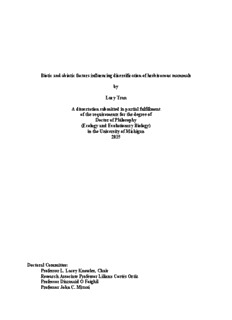
Biotic and abiotic factors influencing diversification of herbivorous mammals by Lucy Tran A ... PDF
Preview Biotic and abiotic factors influencing diversification of herbivorous mammals by Lucy Tran A ...
Biotic and abiotic factors influencing diversification of herbivorous mammals by Lucy Tran A dissertation submitted in partial fulfillment of the requirements for the degree of Doctor of Philosophy (Ecology and Evolutionary Biology) in the University of Michigan 2015 Doctoral Committee: Professor L. Lacey Knowles, Chair Research Associate Professor Liliana Cortés Ortiz Professor Diarmaid Ó Foighil Professor John C. Mitani © Lucy Tran 2015 To my parents, for allowing me to follow my dreams, and to Joe, for supporting me while I pursue them ii ACKNOWLEDGEMENTS I am forever grateful to Lacey Knowles, Liliana Cortés Ortiz, John Mitani, Diarmaid Ó Foighil, Miriam Zelditch, Dan Rabosky, Catherine Badgley, Qixin He, Anna Papadoupoulou, and Diego Alvarado Serrano for the valuable and thought-provoking discussions of science throughout my graduate training. Miriam Zelditch, Diego Alvarado Serrano, Eladio Marquez, Elen Oneal, Raquel Marchan-Rivadeneira, and Hayley Lanier are recognized for their instrumental guidance with morphometrics for Chapter II and Carlos Anderson for troubleshooting the BAMM analyses for Chapter III. I am indebted to Anna Papadopoulou, Qixin He, Mark Christie, Pavel Klimov, Raquel Marchan-Rivadeneira, and Joseph Knoedler for their insightful comments on previous versions of the manuscripts comprising this dissertation. Thanks are also owed to the members of the Knowles lab throughout the years for the scientific enrichment, in particular John McCormack, Amanda June Zellmer, Danielle Edwards, Huateng Huang, and Tim Connallon. I cannot thank Ken Nagy, Travis Longcore, and my Spring 2006 Field Biology Quarter friends enough for introducing me to the joys of field research. Thea Wang, Kyle Larson, Corey Duberstein, and Shauna Price were inspiring research mentors and role models. I could not have completed this thesis without the sanity check provided by my friends (near or far) throughout the years, especially Linda Quach, Nancy Su, Rachel Cohen, Jenabel Lee, Qixin He, Kelsey Pressler, Jingchun Li, Leiling Tao, Gyorgy Barabas, and Michael Sheehan. You all have my deepest gratitude. Funding for this dissertation was generously provided by the Museum of iii Zoology Hinsdale and Walker Awards, EEB Block grants, Rackham International Research Award, American Society of Mammalogists Grants-in-Aid, and a National Science Foundation Graduate Research Fellowship. iv TABLE OF CONTENTS DEDICATION.................................................................................................................................ii ACKNOWLEDGEMENTS............................................................................................................iii LIST OF TABLES..........................................................................................................................vi LIST OF FIGURES......................................................................................................................viii ABSTRACT.....................................................................................................................................x CHAPTER I: INTRODUCTION.....................................................................................................1 CHAPTER II: THE ROLE OF ECOLOGICAL OPPORTUNITY IN SHAPING DISPARATE DIVERSIFICATION TRAJECTORIES IN A BICONTINENTAL PRIMATE RADIATION...10 CHAPTER III: INTERACTION BETWEEN DIGESTIVE STRATEGY AND NICHE SPECIALIZATION PREDICTS SPECIATION RATES ACROSS HERBIVOROUS MAMMALS..................................................................................................................................61 CHAPTER IV: BOUNDS OF HISTORICAL CLIMATIC INSTABILITY DIFFER AMONG HERBIVOROUS MAMMALS...................................................................................................113 CHAPTER V: CONCLUSION....................................................................................................166 v LIST OF TABLES Table 2.1. Fits of diversification models to phylogenetic data......................................................28 Table 2.2. Fits of the folivory-dependent speciation and extinction models.................................29 Table S2.1. Landmarks and semilandmarks of mandible shape....................................................30 Table S2.2. Cranio-mandibular dental (CMD) characters.............................................................31 Table S2.3. Taxonomy of colobine monkeys (subfamily Colobinae)...........................................34 Table S2.4. Diet data of species.....................................................................................................35 Table S2.5. Fits of diversification models to phylogenetic data....................................................37 Table S2.6. Fits of the folivory-dependent speciation and extinction models...............................38 Table 3.1. Lineages of terrestrial, herbivorous mammals that were analyzed in this study..........81 Table 3.2. Phylogenetic generalized least-squares regressions.....................................................82 Table S3.1. List of sources for trophic level and fermentation state of species considered in this study...............................................................................................................................................83 Table S3.2. List of dietary items in primate species' diets, reclassified using the PanTHERIA scheme............................................................................................................................................94 Table S3.3. Description of variables used to compute the maximum environmental disparity metric.............................................................................................................................................97 Table 4.1. Description of variables used to calculate multivariate climate anomaly..................133 Table 4.2. Phylogenetic signal of multivariate climate anomaly and species richness...............134 vi Table 4.3. Models of trait evolution for multivariate climate anomaly and species richness......135 Table 4.4. Scores from phylogenetic principal components analysis (PCA) of climate anomaly. ......................................................................................................................................................136 Table 4.5. Species at climatic instability limits of hindgut and foregut-fermenting mammals...137 Table 4.6. Regression analyses of climate anomaly and species richness...................................138 Table S4.1. Area under the operator receiving curve (AUC) of MaxEnt models for species analyzed in this study...................................................................................................................139 vii LIST OF FIGURES Figure 2.1. Lineage-through-time plots of the African and Asian clades......................................39 Figure 2.2. Disparity through time of feeding morphology...........................................................40 Figure 2.3. Folivory-dependent rates of speciation and extinction................................................41 Figure S2.1. Gamma statistics for the phylogenies........................................................................42 Figure S2.2. Node height tests of feeding morphology.................................................................43 Figure S2.3. Phylogeny of Colobinae............................................................................................44 Figure 3.1. Cladogram of 46 lineages of terrestrial, herbivorous mammals selected for comparative analyses.....................................................................................................................98 Figure 3.2. Relationship between niche specialization and speciation..........................................99 Figure 3.3. Differences in niche specialization between foregut and hindgut-fermenting clades. ......................................................................................................................................................100 Figure 3.4. Differences in speciation between foregut and hindgut-fermenting clades..............101 Figure S3.1. Scatterplot of diet breadth reclassified in this study and data from PanTHERIA for primates........................................................................................................................................102 Figure 4.1. Maps of species richness...........................................................................................150 Figure 4.2. Plot of phylogenetic principal components of climate anomaly...............................151 Figure 4.3. Phylogenetic principal components bi-plot...............................................................152 Figure 4.4. Comparisons of climate anomaly and species richness between hindgut and foregut- viii fermenting mammals...................................................................................................................153 Figure 4.5. Geographic distributions of artiodactyl species at limits of climatic instability.......154 Figure 4.6. Climatic instability space of herbivorous mammals.................................................155 ix
Description: